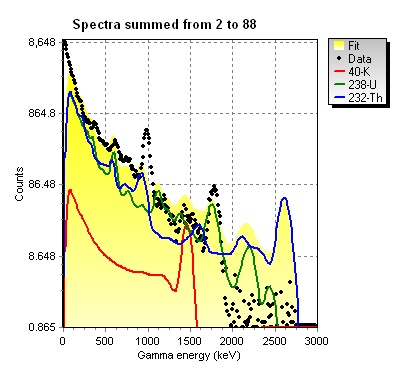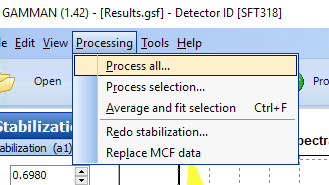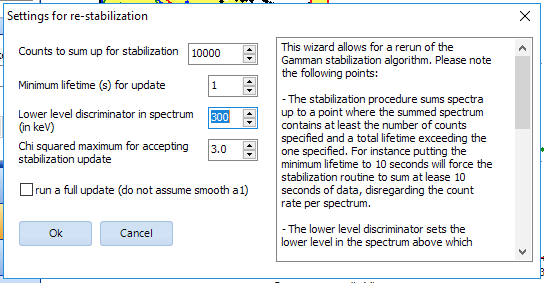4. Energy stabilisation of spectra
The energy, or "gain" stabilisation of gamma spectra is a procedure in which every measured (multichannel) spectrum is shifted in such a way, that the channel axis (the X axis) is converted in an axis displaying gamma energies. The conversion, or 'mapping' function should be such that all peaks present in the spectrum end up at the corresponding gamma energy. For instance, the 40K peak should pop up at 1460 keV, the highest 232Th peak should be found at about 2620 keV.
4.1 Real life data
However, the problem in "real life" data is that the positions of the peaks depends on several, detector- and environment-driven factors. The high voltage applied to the detector determines the amplification ("gain") of a system and thereby the position of the peaks in a MCA spectrum. At the same time, the gain is determined by the temperature of the detector system. Improper or poorly designed multichannel analysers may even show non-linear gain issues, leading to abnormal peak shifts in the measured spectrum. All these factors are taken care of in the Gamman Stabilisation Algorithm.

Improper stabilization. The measured spectrum (black dots) has peaks at the wrong peaks of the standard spectra.

Correct stabilization. The measured spectrum fits nicely over the standard spectra.
In general one can separate the spectral shift compared to a fixed energy axis into a "static" part (a part depending on type of MCA used, high voltage applied, other system settings) and a "dynamic" part. The static part of the stabilisation is determined in the calibration of a detector. During calibration, both a zero offset and a-linearity of the detector-MCA system is determined.
The 'dynamic' part stems primarily from the detector temperature, which normally is changing over time (during a survey). The dynamic part is therefore a-priori unknown, and must be determined again for each individual spectrum.
4.2 The Gamman gain stabilisation
In Gamman, gain stabilisation is done by translating each and every MCA spectrum in an input file, to an energy-stabilised spectrum. This is done by applying a mapping function
in which F is an nth order polynomial function mapping each channel number i to a gamma energy:
The constants ai..n the polynomial mapping function F are continuously adapted to the potentially varying gain stabilisation of the detector system. In general, only the first order factor a1 varies with temperature-induced gain. The variation of a1 is traced by inspecting each individual spectrum and by adjusting a1, if needed.
The stabilisation algorithm uses the fact that the nuclides contributing to the spectrum are known a-priori. It uses data from a calibration file of your detector system to find the gain stabilisation for a given data set. This is done by finding the optimum fit while adjusting the polynomial constants ai.
The optimum fit is found whenever the gain stabilisation is proper (see figures above).
4.3 The Gamman method
The gain stabilisation of your spectra is performed whenever Gamman imports "raw MCA spectra". That is, spectra that have not been stabilised before. The Gamman output (GSF files) contains gain-stabilised spectra. However, note that Gamman offers the possibility of re-adjusting the stabilisation in a later in your project. You can change the stabilisation of individual or groups of spectra by selecting the "Stabilisation" tab in the spectral view of Gamman (see figure below).

Changing the stabilization of a spectrum can be done by selecting the "stabilization"tab.
You can also re-run the complete process via the menu-item "Redo Stabilisation", as can be seen in the image below. This opens a dialog box that allows to re-run the stabilisation algorithm for the complete dataset in your project.


The settings of this box are explained in the text field on the right.
4.5 Precautions
There are two situations that may lead to strange or erroneous results of the stabilisation algorithm:
- Unknown radioactive substances are present in your data set;
- Improper or outdated calibration data for your detector is used for stabilisation.
Ad. 1. Radiation from nuclides that are not part of the calibration information for your detector, will lead to peaks at unknown positions. In that situation, the algorithm will not find an optimum fit and may introduce false gain stabilisation. For instance, if a Na22 source would be present in your measurement area, peaks would show up at 511 and 1120 keV. These peaks are not found in the calibration information, and the software will most likely try to translate the 1120 peak to the position of the 40K peak (at 1460 keV). This situation can be solved by acquiring a calibration set including the wanted nuclide.
Ad. 2. Detectors will degrade over time. Their peak resolution may become worse and/or peaks will be smeared out because of crystal cracks and other damage. Or, even worse, complete detectors or MCA hardware may be replaced. This will lead to a system having a different set of static gain stabilisation parameters than present in the Gamman calibration files. Such a situation may lead to improper gain stabilisation. It is always advisable to do a regular recalibration of your detector system.
